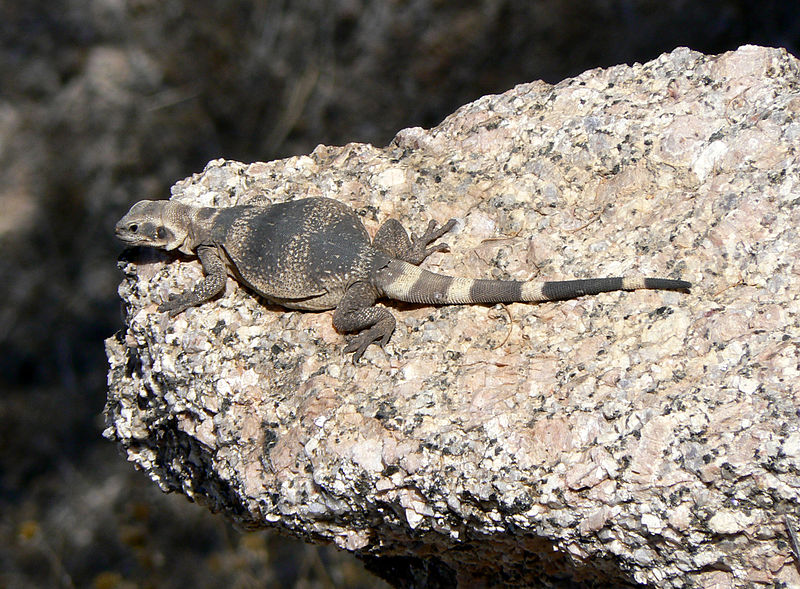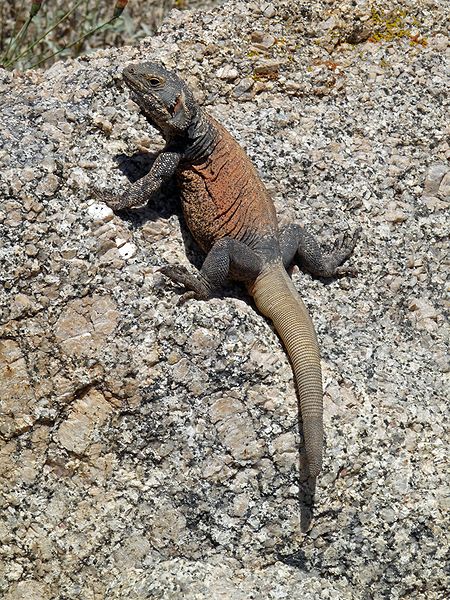 The stocky Chuckwalla (Sauromalus obesus) is one of my all-time favorite lizards. Years ago, I and others found it a quite difficult captive, as little was known of its high UVB requirements. Today, however, its husbandry is well-understood, and captive bred animals are readily available.
The stocky Chuckwalla (Sauromalus obesus) is one of my all-time favorite lizards. Years ago, I and others found it a quite difficult captive, as little was known of its high UVB requirements. Today, however, its husbandry is well-understood, and captive bred animals are readily available.
Food and hot basking sites are the focal points of the Chuckwalla’s life – provide it with each in proper form and you’ll find yourself with a most responsive and interesting pet. Most take quickly to hand feeding, and their vegetable-dominated diet is a plus for many herp enthusiasts.
Description
The body is squat with loose skin folds along the neck and sides, and is colored reddish to light gray with a pale yellow tail. The head, chest and limbs of males are usually black, but some sport very impressive red coloration. Females and young animals (and, for some reason, males in SW Utah) are marked with dark bars.
Adult size varies from 6-18 inches, depending upon location and subspecies. Among lizards native to the USA, large adults are exceeded in size only by the Gila Monster (Heloderma horridum).
Chuckwallas belong to the Family Iguanidae which, as originally conceived, contained over 700 species. Recent taxonomic revisions have left the family with 36 species. S. obesus and S. ater are considered to be the same species by some taxonomists.
“Chuckwalla” is derived from the word caxwal, the name given the lizard by the Cahuilla People and which was later recorded by the Spanish as chacahuala.
Range
 The most commonly available species, Sauromalus obesus, inhabits southwestern North America, within the Mojave and Sonoran Deserts and surrouning areas. It ranges from California through southern Nevada, southern Utah, western Arizona and northern Mexico (Baja California and western Sonora). Four subspecies are recognized.
The most commonly available species, Sauromalus obesus, inhabits southwestern North America, within the Mojave and Sonoran Deserts and surrouning areas. It ranges from California through southern Nevada, southern Utah, western Arizona and northern Mexico (Baja California and western Sonora). Four subspecies are recognized.
Five additional species of Chuckwalla occur in Mexico and on several islands in the Gulf of California.
Habitat
Chuckwallas are quite specific in their habitat requirements, being limited to rocky areas within deserts. Lava flows, rock piles, outcroppings and rocky hillsides are typical Chuckwalla habitat, and in undisturbed sites may support large populations. They are diurnal and rely upon rocks for basking and to facilitate their unique escape behavior (please see Part II of this article for details).
Further Reading
Excellent photos of Chuckwallas and their habitat, as well as further natural history information, are posted here.
A very good video showing wild Chuckwallas and their defensive behavior is posted here.
Chuckwalla and juvenile Chuckwalla images referenced from wikipedia and originally posted by Azhikerdude
 That Reptile Blog – Reptile, Amphibian and Exotic Pet Care and Information
That Reptile Blog – Reptile, Amphibian and Exotic Pet Care and Information



Frank, I rescued a juvenile sauromalus obesus from my swimming pool – I assume it’s quite young at under seven inches in length – and decided to attempt its husbandry. I procured a 30 gallon tank (for the interim – if things work out, I intend to construct a larger environment later) and what I hope is appropriate lighting (two brooding lamps: one emitting UV from a 23 actual wattage CFL bulb, one emitting IR from a 40 actual wattage incandescent IR bulb). I provide a daily ration of finely chopped romaine lettuce and a small amount of finely chopped carrot, which I’ve seen the animal consume, and some water in a very small saucer (too small for the animal to attempt to bathe in it). Two questions:
1. As the animal has become acclimated to its captivity, I note that, during daytime, it roams the sides of the terrarium in apparent attempts to escape almost without surcease (however, it does nest under the rocks at night). Is this normal?
2. I’ve seen conflicting information on the web about making water available to these animals. Is it your certain recommendation to ensure the animal has water all the time?
Thank you in advance for your advice.
Hello,
Thanks for your interest. I’m not familiar with the bulbs you mention; UVB exposure is critical, I recommend bulbs specifically designed for desert reptiles. Please send more info on yours if possible, or let me know if you need links to other bulbs. The basking site should be 100-110F, temps in rest of tank can range from 82-90F. Escape behavior may be due to heat stress – in a 30 gallon tank, it’s difficult to provide a gradient – if the basking site is at 100, the tank tends to take on that temperature. You may need to alternate the basking bulb with a lower wattage bulb. Please let me know if you need more info.
The diet should be more varied, as described here.. Meals should be powdered 3-5x weekly with calcium and vitamin supplements; pl let me know if you need specific info..
Please note that chuckwallas are protected over most of their range, so you may wish to consult your state wildlife agency. Captive born animals are available; they can be quite hardy, but UVB, temperature and diet must be carefully considered or they will not thrive.
Best regards, Frank
thanks for this great site
best regards hannes
Thanks for the kind words, Best, Frank